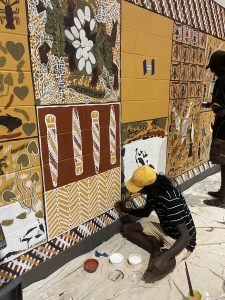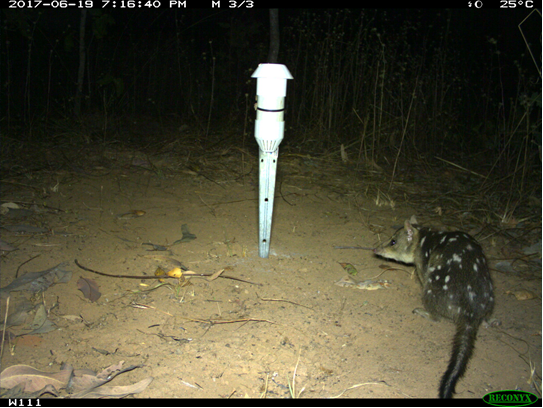Foundation for Rural & Regional Renewal (FRRR)
Ramingining, an Aboriginal community home to around 870 people, is situated on the edge of the Arafura Swamp in Arnhem Land, approximately 560 kilometres east of Darwin in the NT. The community is made up of mainly Yolngu people.
Ramingining artists and community members, through the Bula’Bula Arts Centre, wanted to provide more activities that strengthen the community’s connection to their cultural roots, knowing this is integral to people’s health and wellbeing. They also wanted their young people to learn to practice and celebrate their culture from Elders.
Following Cyclone Lam in 2015, the community successfully lobbied for a new cyclone shelter. The completed shelter has multiple uses including as recreation centre, a space for youth programs, a basketball stadium and the occasional movie theatre. The concrete block building was practical but somewhat bland, without representation of the local Yolngu culture.
Thanks to a $9,973 Strengthening Rural Communities grant, funded by the Bertalli Family Foundation, the Bula’Bula Arts Centre was able to bring together the older and younger generations of Yolngu people to commemorate their culture through the creation of two large public murals on the outside walls of the cyclone shelter.
Yolngu culture is built on a kinship system that consists of two moieties, Dhuwa and Yirritja, and these are the foundations of the skin systems, totemic relationships, storylines, songlines and more. Each mural, approximately three by five metres, honours one of the two moieties. The murals are a huge achievement visually depicting 20 unique stories. Twenty-one Bula’Bula artists, alongside about 20 Ramingining youth, created the murals over several sessions during the January 2022 school holidays.

The painting sessions were observed by many other community members, who came along to see what was happening. The murals have been highly welcomed by the community, bringing smiles and words like letchu (awesome), manymak (great) and yolngu rom (our culture).
The younger people have developed a better understanding of their culture, and the broader community has a greater sense of pride and self-esteem from the creation of a more culturally appropriate meeting place. The murals also act as a teaching tool, with many families coming to show their children and tell the culturally significant stories.
The Bula’Bula Arts Centre is a locally governed, owned, and operated Aboriginal Corporation situated in the heart of the community and plays an important role supporting more than 150 artists to maintain and strengthen their cultural practices. It also offers training, education, career pathways and enterprise opportunities, along with providing social services contributing to the social and physical health of the community.
The most successful and proudest part of the project for the Bula’Bula Arts Centre was the engagement of Yolngu people from the initial concept to execution and finally, the outcome and ongoing nature of keeping culture strong.
Dhuwa wall artists included: Gary Smith, Dorothy Djampilil, Daniel Warrulukuma, Evonne Rraraypum, JB Fisher, Joy Borruwa, Billy Black, Joy Burruna, Lisa Gurrulpa and Shannon Ashley.
Yirritja wall artists included: Joanne Mombuyngu, Selena Munguluma, Peter Gambung, Romeo Gaykamangu, Bobby Bununggurr, Andrew Malibirr, Johnny Malibirr and Evonne Gaywrri.
Artist helpers and art workers: Selena Galang, Kylie Pascoe, Steve Malibirr, Ross Dhaparuwuy and Jasmane Malibirr.
The East Arnhem Regional Council authorised the creation of the murals and also provided staff time in-kind to assist with the project.

Warddeken, an Aboriginal owned not-for-profit company, combines traditional ecological knowledge with Western science to manage and protect one of Australia’s most unique environments.

Arnhem Land covers 97,000 sq km of the top end of the Northern Territory.
During the second half of the twentieth century, many Traditional Owners were encouraged to move away from either remote parts of Arnhem Land and join missions, or larger communities to search for more ‘traditional’ work opportunities.
As a result, many parts of the area were left without people and ‘Country was orphaned’ – the term used for land without its people.
Over a number of decades fine-scale fire management was replaced by raging yearly wildfires, feral animals and invasive plants severely impacting the native species.
The plants and animals that make up the local ecosystems had previously evolved to rely on Bininj (the Aboriginal people of Western Arnhem Land), however the disruption in traditional Indigenous land management diminished the ecosystem and led to plummeting numbers of small to medium–weight mammals. This included culturally important species like djabbo / northern quoll and bakkadji / black-footed tree-rat. Refugia, including rainforest patches shrunk and fresh-water places were destroyed.
Getting things back on track
Warddeken is an Aboriginal-owned, not-for-profit company that combines traditional ecological knowledge with Western science to manage and protect one of Australia’s most unique environments.
Warddeken operates out of the remote homeland communities of Kabulwarnamyo, Manmoyi and Mamadawerre in west Arnhem Land. Each year up to 180 Indigenous rangers work on a variety of projects including fire management and carbon abatement, invasive weed and feral animal control, rock art conservation, education and cultural heritage management.
In 2010 Aboriginal Elders from the Warddeken and Djelk IPAs established the Karrkad-Kanjdji Trust to seek philanthropic sources of funding for land management and cultural projects.
Last year, they received a $15,000 Seeds of Renewal grant from ANZ and FRRR to help fund a network of cameras that look into the prevalence of djabbo (northern quoll) on the land to understand the impact of its own land management practices and programs on this priority mammal species.

Curbing the decline
Djabbo populations identified by the monitoring project are actively considered in annual early burning and wildfire suppression activities, and are targeted for further investigation for the purposes of building population resilience.
With meaningful involvement and employment of landowners and rangers, Warddeken will seek to define quoll and major predator feral cat population density and distribution to inform the design of predator suppression strategies if required.
Indigenous rangers, living and working on Country, are best placed to curb the decline in native biodiversity loss and improve habitat for future generations.
Rangers in West and Central Arnhem Land tirelessly blend Indigenous ecological knowledge and western science to control threats and help native species begin to thrive in their natural environment.
CEO of Karrkad Kanjdji Trust, Stacey Irving says “Warddeken’s vision is to have healthy people living and working on healthy country. The generous support of the ANZ Seeds of Renewal program is helping rangers care for species like the Djabbo.’’
Terrah Guymala, Senior Warddeken Ranger adds, “When we, Bininj people, see animals, we get excited because they play a big role in our life through our ceremonies.
“This year we have seen lots of animals that we love, but we hope this number increases so we can physically show our children rather than relying on rock art to tell the stories,” Terrah says.
ANZ General Manager Business Banking Jenefer Stewart says the ANZ Seeds of Renewal program has been providing grants for important initiatives in regional and rural Australia for nearly 20 years.
“Each year I look forward to seeing the difference the grants are able to make in these communities, many of which find it difficult to access the resources they need to grow, develop and prosper,” she says.
Written by Karly Dwyer, ANZ

